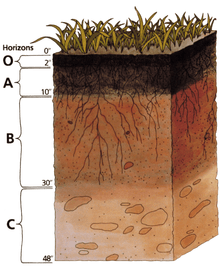Soil color
Soil color does not affect the behavior and use of soil; however, it can indicate the composition of the soil and give clues to the conditions that the soil is subjected to. [1] Soil can exhibit a wide range of colour; gray, black, white, reds, browns, yellows and under the right conditions green. [1] Varying horizontal bands of colour in the soil often identify a specific soil horizon. The development and distribution of color in soil results from chemical and biological weathering, especially redox reactions. As the primary minerals in soil parent material weather, the elements combine into new and colorful compounds. Aerobic conditions produce uniform or gradual color changes, while reducing environments result in disrupted color flow with complex, mottled patterns and points of color concentration.
Causes
Soil color is influenced by the amount of proteins present in the soil. Yellow or red soil indicates the presence of iron oxides.[1] Dark brown or black color in soil indicates that the soil has a high organic matter content. Wet soil will appear darker than dry soil.[1] However, the presence of water also affects soil color by affecting the oxidation rate. Soil that has a high water content will have less air in the soil, specifically less oxygen. In well drained (and therefore oxygen rich soils) red and brown colors caused by oxidation are more common, as opposed to in wet (low oxygen) soils where the soil usually appears grey.[1]
The presence of specific minerals can also affect soil color. Manganese oxide causes a black color, glauconite makes the soil green, and calcite can make soil in arid regions appear white.[1]
Classification
Often described by using general terms, such as dark brown, yellowish brown, etc., soil colors are also described more technically by using Munsell soil color charts, which separate color into components of hue (relation to red, yellow and blue), value (lightness or darkness) and chroma (paleness or strength).
References
Further reading
- "The Color of Soil". United States Department of Agriculture - Natural Resources Conservation Service. Archived from the original on 2007-10-27. Retrieved 2007-11-25.
- "Soil Color Contrast". United States Department of Agriculture - Natural Resources Conservation Service. Retrieved 2007-11-25.
- "Why is the ground brown". Retrieved 2007-11-25.
